Along with snowdrops, squills are among the plants that flower first thing in the new yearpresent.

The blue, star-shaped flowers can be found along the way and in meadows as early as February. In addition to the native species of squill (Scilla) you can also keep other species in the garden as an ornamental plant.
contents
- Squill: flowering time and properties
- The most beautiful types and varieties
- Planting Scilla: location and procedure
- The right care
- Is the squill poisonous?
Squill: flowering time and properties
By the Bluestar (Scilla) is a plant genus that, as a geophyte, develops its outlasting organs in the soil in the form of bulbs. Squills are found in Asia and Europe. The two-leaved squill thrives in southern and south-eastern Germany (Scilla bifolia) mostly near rivers, in wet areas such as riparian forests. These native occurrences of squill are protected.
The genus Scilla contains a total of about 83 species, including, for example, the
Tip: Luckily, squill bulbs are of no interest to voles.
In early spring, as one of the first heralds of spring, the squill sprout and its leaves sprout from the ground. The flowering period of the squill, which you can find in our garden, follows shortly thereafter and extends from February to April. The squill is therefore an early bloomer. But there are also species that flower later in the year. The pretty flowers are mostly blue, sometimes purple or white. The decorative early bloomers can also be found under the name Blausternchen or Szilla. After flowering, the squill draws back its leaves in summer and sprout again in the following spring.

When does the squill bloom? Depending on the species, the squill has its flowering period between February and September. Our native two-leaf squill (Scilla bifolia) blooms from about February to April, shortly after the snowdrop (Galanthus).
The most beautiful types and varieties
With the multitude of Scilla-Varieties can be hard to decide on. Here we present the most beautiful and popular squill varieties and species.
Two-Leaf Squill (Scilla bifolia): This native wild plant is not only suitable for the garden. They can also be found in parks and by the wayside when the erect, star-shaped, blue flowers show up in spring. Despite the small height of 10 cm, this native squill has a high value for pollinators. The species tolerates lime, is quite competitive and grows on moist, fresh, nutrient-rich soil on partially shaded forest edges.
- 'Alba': Forms flowers in white.
- 'Rose': Has flowers in pink.
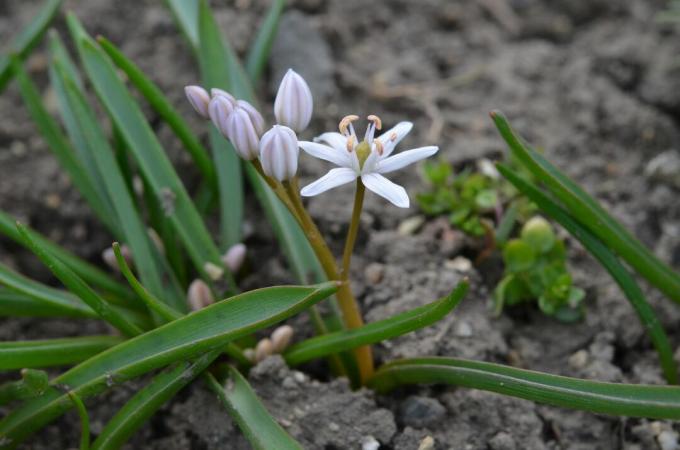
Siberian Squill (Scilla siberica): This species is also a popular garden plant, reaching heights of about 10 cm. The flowers are blue with a blue central stripe on the petal. The shape is rather bell-shaped and the flowers sit nodding on the stems. Like the two-leaved squill, this species is competitive and loves lime. It grows particularly well on heavy, clay-rich soil and in light semi-shade.
- 'Spring Beauty': Higher and stronger growing variety with even deeper blue flowers.
- 'Alba': Flowers white.
- 'Grace Loft House': Rare variety in purple-blue.
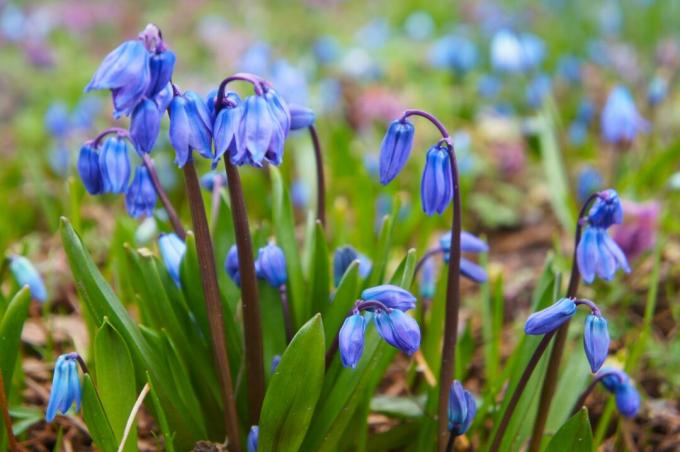
Mishchenko Squill (Scilla mishchenkoana): This species grows to about 20cm in height, making it the largest squill species for the garden. The Mishchenko squill flowers white and not blue. Since it occurs naturally in mountains, it is more suited to slightly more drained, drier soils that are in full sun or part shade. The species is also called Russian squill or Caucasian squill.
- 'Zwanenburg': With light blue flowers.
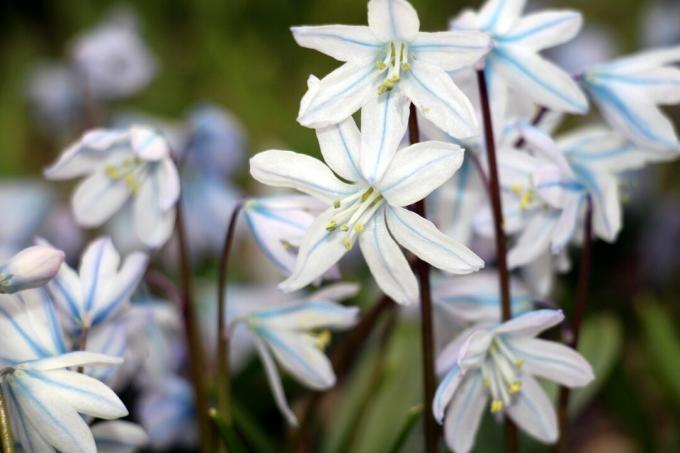
Tip: The Peruvian Squill (Scilla peruviana) has many small purple flowers arranged in a capitate inflorescence. This species, which originates from the Mediterranean region, is only used as an ornamental plant in warm regions. Unlike the other varieties, the evergreen Peruvian squill is not hardy. The heat-loving plant must be overwintered at at least 5 °C and has its flowering period from May to June. The species should be fertilized and watered regularly during the vegetation period and needs a bright location.
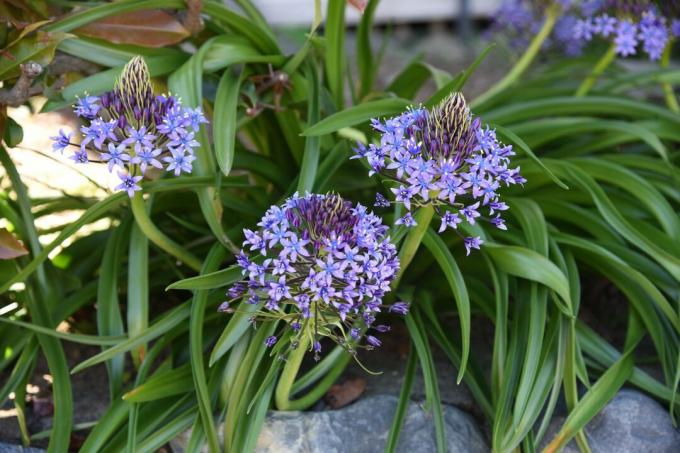
Planting Scilla: location and procedure
Before planting the squill, it is important to find a location that suits the needs of the early bloomer. The squill does need light, but due to the early flowering period, it can also be placed under deciduous trees, as these do not yet have any leaves at the time of flowering. A suitable spot is light or semi-shady and soil preferences depend on the each species - the above list of species and varieties gives you information about the requirements of your squills.
Squills are planted in autumn, between September and November.
Planting in groups or small groups of at least 5 to 20 bulbs later gives an attractive overall picture. Since squills do not grow large, a distance of about 10 cm between the bulbs is sufficient, which corresponds to about 100 plants per square meter.
Tip: If you are patient, you can plant fewer plants per square meter. The squill then forms a self-contained population at suitable locations.
In the fall between October and November, the onions planted about 8 cm deep in the ground with the tip upwards. Then everything is covered with substrate and lightly cast.
In January there are also squill bulbs that have already been pushed forward. These are suitable for keeping in a pot, for example on the sheltered balcony or in the apartment. For planting in pots, it is best to use a humus-rich substrate, such as ours Plantura organic potting soil. The high humus content and the nutrients it contains as well as the loose structure ensure the best growing conditions. After flowering, the squill draws back its leaves. The bulbs can be planted outside in autumn or overwintered in a pot in a cool, frost-free place, after which they will sprout again the following year. If you bring the squill pot indoors in December or January, water it and fertilize it, you can enjoy the blue splendor that is springing up again particularly early.
Tip: The two-leaved squill is very propagating and forms beautiful, blue carpets of flowers over time. It can therefore also be planted well in the lawn.
The right care
Squills are one of the undemanding garden plants. Care for the squill is limited to soil preparation when planting and evenly moist soil. Watering is especially important from planting until the end of the flowering period, when the foliage is withdrawn. This allows the squill bulbs to sprout again next year. However, it must not get wet, otherwise the onion will soon suffer from rotting agents.
tip: The foliage should never be cut or mowed, because it is important for the further care of the bulb and thus the flowering in the next year.
Fertilization is usually not necessary. On poorer soils, a little slow-release fertilizer can be worked into the soil for supply in the spring. Bring a fertilizer for flowering plants, such as ours Plantura organic flower fertilizer, in spring as soon as the leaves begin to sprout. Our organic fertilizer lasts up to three months and is safe for pets and garden animals. In this way, the squill receives sufficient nutrients for a magnificent flowering period.
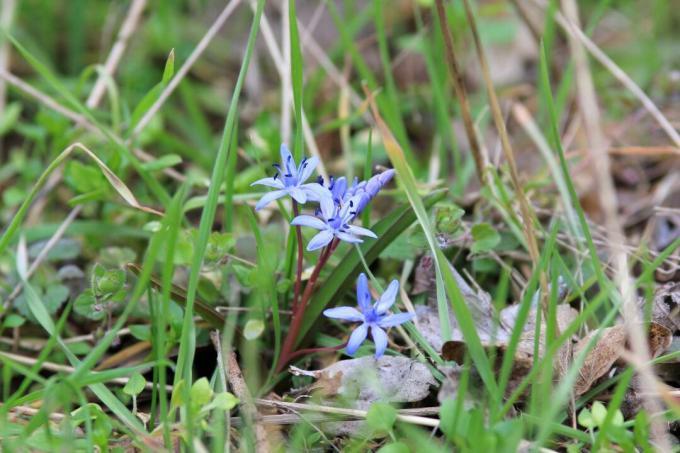
The squill is usually hardy. The bulbs even need the cool temperatures to sprout in spring. Cold weather with temperatures down to – 23 °C does not bother the squill.
Tip: The squill propagates via seeds. The individual seeds have appendages, the eleiosomes, which are sought after by ants because of their fat content. These carry the seeds to their burrow, which helps spread the squill.
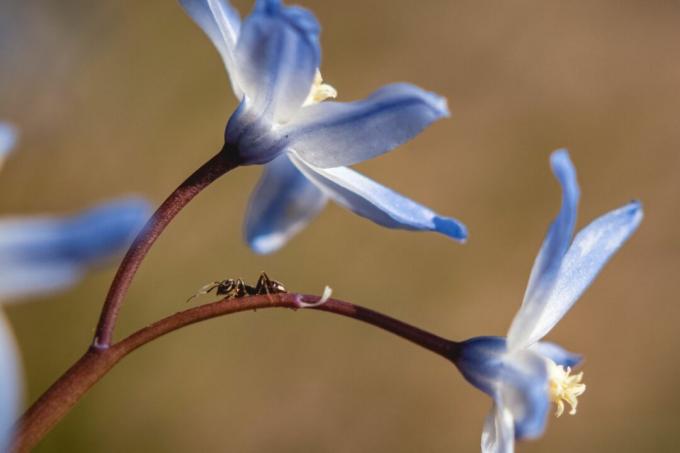
Is the squill poisonous?
The squill is poisonous and should not be consumed. This applies not only to humans, but also to pets such as dogs or cats. The juice it contains can already lead to irritation if it comes into contact with the skin.
But not only squill and snowdrop bloom in early spring. We have an overview of 15 most popular early bloomers compiled for you.
